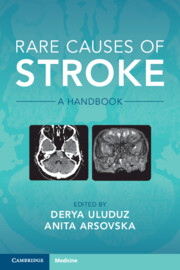Book contents
- Rare Causes of Stroke
- Rare Causes of Stroke
- Copyright page
- Contents
- Contributors
- Preface
- 1 Inflammatory Conditions
- 2 Infectious and Postinfectious Vasculitis
- Chapter 2.1 Meningovascular Syphilis
- Chapter 2.2 Neuroborreliosis
- Chapter 2.3 Tuberculosis Meningitis
- Chapter 2.4 Bacterial Meningitis
- Chapter 2.5 Neurocysticercosis
- Chapter 2.6 Varicella-Zoster Virus-Related: Cytomegalovirus (CMV) and Herpes Infections
- Chapter 2.7 HIV Infection
- Chapter 2.8 Chagas Disease
- 3 Hypercoagulable Causes of Stroke
- 4 Drug-Related Stroke
- 5 Hereditary and Genetic Causes of Stroke
- 6 Rare Causes of Cardioembolism
- 7 Vasospastic Conditions and Other Vasculopathies
- 8 Other Non-inflammatory Vasculopathies
- 9 Venous Occlusive Conditions
- 10 Bone Disorders and Stroke
- Index
- References
Chapter 2.2 - Neuroborreliosis
from 2 - Infectious and Postinfectious Vasculitis
Published online by Cambridge University Press: 06 October 2022
- Rare Causes of Stroke
- Rare Causes of Stroke
- Copyright page
- Contents
- Contributors
- Preface
- 1 Inflammatory Conditions
- 2 Infectious and Postinfectious Vasculitis
- Chapter 2.1 Meningovascular Syphilis
- Chapter 2.2 Neuroborreliosis
- Chapter 2.3 Tuberculosis Meningitis
- Chapter 2.4 Bacterial Meningitis
- Chapter 2.5 Neurocysticercosis
- Chapter 2.6 Varicella-Zoster Virus-Related: Cytomegalovirus (CMV) and Herpes Infections
- Chapter 2.7 HIV Infection
- Chapter 2.8 Chagas Disease
- 3 Hypercoagulable Causes of Stroke
- 4 Drug-Related Stroke
- 5 Hereditary and Genetic Causes of Stroke
- 6 Rare Causes of Cardioembolism
- 7 Vasospastic Conditions and Other Vasculopathies
- 8 Other Non-inflammatory Vasculopathies
- 9 Venous Occlusive Conditions
- 10 Bone Disorders and Stroke
- Index
- References
Summary
Lyme disease, caused by the spirochetes of Borrelia burgdorferi (Bb) genospecies, is the most common vector-borne, infectious disease in Europe and North America. The clinical presentation varies with the disease stage. Different syndromes were described, and atypical symptoms can result in diagnostic delay or misdiagnosis. Neurological manifestations of systemic infection often referred to as Lyme neuroborreliosis (LNB), are reported in up to 15% of patients, while cerebrovascular events are even less frequent, published only in small case series. The distinction between early and late LNB is useful, with cranial neuritis and radiculitis occurring more in the former and mild encephalopathy, peripheral neuropathy, or stroke in the latter. There are no specific clinical or radiological characteristics, and diagnosis is based on different criteria, which can pose a challenge. Diagnosis of definite LNB relies on a combination of history, neurological examination, routine analysis of cerebrospinal fluid (CSF) along with Bb-specific antibody studies of serum and CSF. The pathophysiological mechanism of LNB remains elusive; however, it seems based on both bacterial involvement and amplified immune response. Appropriate antibiotic treatment can result in a regression of neurological deficits. Finally, the question of an LNB-induced cerebrovascular event should be raised in patients with cryptogenic, multi-territorial strokes without risk factors, alongside radiological signs of vasculitis, and who live in an endemic area and have a history of a tick bite
Keywords
- Type
- Chapter
- Information
- Rare Causes of StrokeA Handbook, pp. 112 - 118Publisher: Cambridge University PressPrint publication year: 2022

